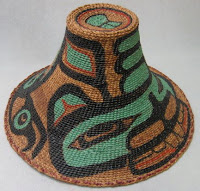 |
Beaver Cedar Dance Hat
Collection of Mike Dangeli
|
Using a jerry stripper, Giihlgiigaa cuts a pre-soaked strip of bark into even widths of various lengths. Next, using nothing but his bare hands, starts weaving the strands of bark and slowly starts taking on the shape of a small basket. "I have been doing this for several years, and it’s sort of an obsession," he says.
The Haida had been making useful products from cedar bark for daily use since time immemorial until recently. Haida Gwaii is home to the Haida people, just off the west coast of Canada, south of Alaska. In Old Massett, there is a gallery, where people come to purchase hats, baskets, and other pieces of art. Most of the hats and baskets are made from red or yellow cedar bark that is harvested on the islands. Red cedar bark is very sturdy and when woven, make strong long lasting storage containers, like a laundry basket and decorative/fashion pieces like hats.
Giihlgiigaa displays his art at various galleries and museum gift shops, as well as a small restaurant. There are about 200-300 artists on Haida Gwaii and probably about %10 are weavers. In addition to baskets, and hats, many weavers also create traditional regalia, such as vests, skirts, aprons, roses, headbands, bracelets and so on. The headbands can vary in width and detail, ranging in price from $20 for a plain thin headband to a 2" wide headband with fur, shell buttons and design for over $200. The later headbands can take up to a couple of weeks to make. Despite changing times, cedar bark is still a good seller, perhaps because it is so strong. Another reason is the aesthetic value, the smell of cedar. Most of the hats sell anywhere from $300 - $2,000 depending on the materials used and way it was made. A normal or contemporary hat costs around $600. A traditional Haida hat, painted would could about $2000 or more depending on the availability of an artist.
But, perhaps weaving has not lost its place, seemingly being replaced by plastic-wares. Cedar weaving, weaving in general is a rare hand craft art that was dying because of the lack of sales in the local and world-wide market. "We would really love to teach this to other people and get them involved in making cedar bark articles. Learning how to transform your environment through doing and education, help foster sustainability and a sense of accomplishment." Weaving is an art form that should be shared with all weavers, as has been done for thousands of years! Even if you’re not a weaver, you can help support a weaver by visiting their art shows at craft fairs, galleries, websites and so on.
by Giihlgiigaa (Todd DeVries)
https://ithkilgaa.blogspot.ca